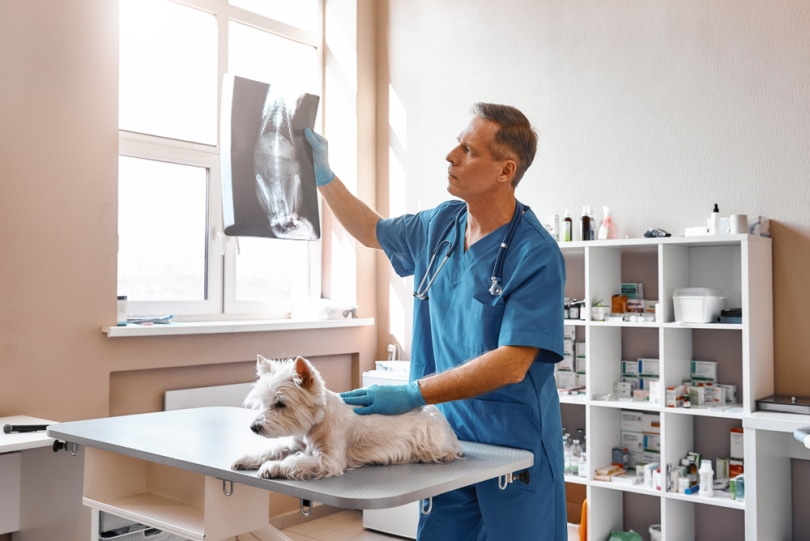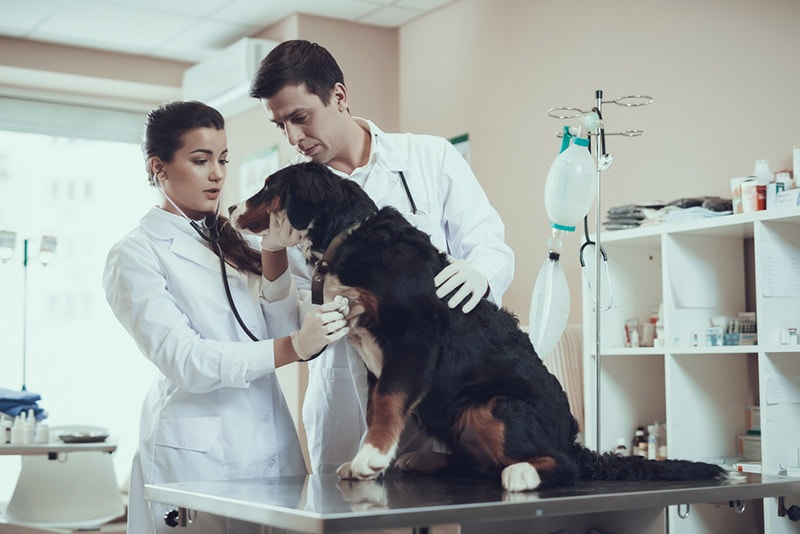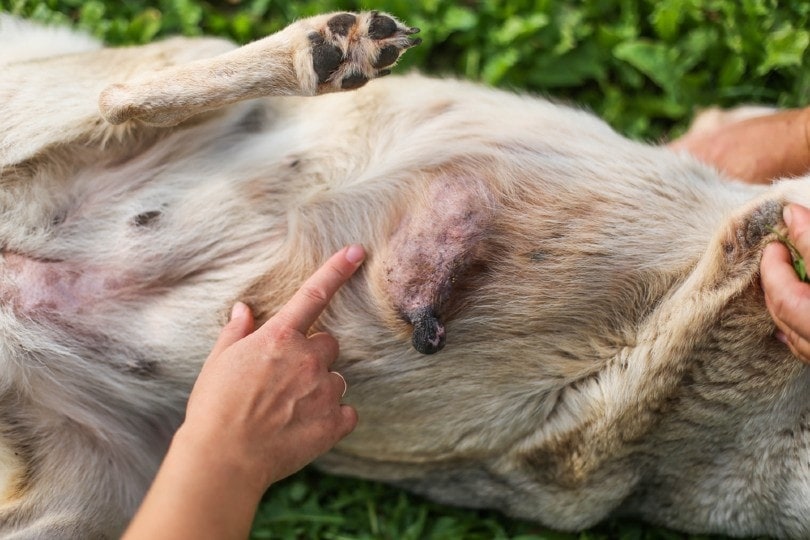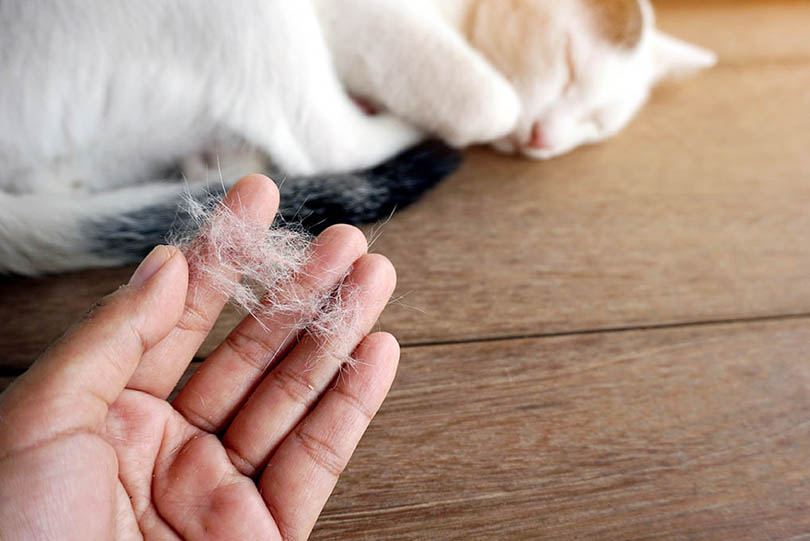Soft Tissue Sarcoma in Dogs: Signs, Causes & Treatment (Vet Answer)

Updated on

Click to Skip Ahead
Soft tissue sarcomas include several subtypes of tumors that develop in the nervous, muscular, or connective tissues of dogs. Basically, they are found under the skin and may originate from various tissues. These tumors can appear in multiple areas of your dog’s body, such as the back, chest, side, face, or legs.
Of the types of skin cancer that can occur in dogs, soft tissue sarcomas represent approximately 15%. The most common subtype of soft tissue sarcoma in dogs is fibrosarcoma.
What Is Soft Tissue Sarcoma in Dogs?
Soft tissue sarcoma is a type of malignant cancer that develops in the soft tissues of the body, including:
- Muscles
- Fat
- Blood vessels
- Nerves
- Tendons
- Joint linings
These soft tissues surround and support the body’s organs. Most dogs diagnosed with soft tissue sarcoma are treated with surgery if the tumor has not spread to other parts of the body (i.e., if it has not metastasized). More aggressive sarcomas are more difficult to treat.
There are several subtypes of soft tissue sarcoma, such as:
- Fibrosarcoma — derived from fibrous tissue
- Lymphangiosarcoma — derived from lymphatic vessels
- Hemangiosarcoma — derived from blood vessels
- Liposarcoma — derived from adipose tissue
- Myxosarcoma — derived from fibrous connective tissue
- Leiomyosarcoma — derived from smooth muscle
- Rhabdomyosarcoma — derived from skeletal muscle
- Synovial sarcoma — derived from the connective tissue lining the joint cavities and tendon sheaths
- Undifferentiated sarcoma
Soft tissue sarcoma has the potential to spread in the body (to metastasize). This potential can be determined by histopathological examination, which will show the grade of the tumor. Grade I and II (low-grade) tumors have a low rate of spread, while grade III tumors have a higher rate.

What Are the Signs of Soft Tissue Sarcoma in Dogs?
The most common clinical sign for dogs with soft tissue sarcoma is a visible mass under the skin that increases in size. However, many of the other clinical signs depend on the affected tissues and the region where the tumor develops.
Clinical signs of soft tissue sarcoma in dogs may include:
- Distinct, firm mass that can be movable under the skin (not attached to the deeper tissues) or immovable (attached to the deeper tissues)
- Pain in the affected area (your dog may lick or bite the affected area frequently or may become aggressive and/or vocalize when touched)
- Walking problems and swelling of the limbs if the tumor occurs on the limbs
- Neurological signs and difficulties in walking if the tumor develops in the nervous tissue
- Clinical signs of an intestinal blockage (vomiting, diarrhea, soft stools, lack of appetite, bloating, and abdominal pain) if the tumor occurs in the digestive tube and blocks the intestine
- Difficulty chewing, bad breath, having an appetite but not eating from food bowl, gingival/oral bleeding, hypersalivation, and the presence of tumors in the mouth (when the sarcoma develops in the mouth)
- Problems with urination, defecation, or reproduction when the sarcoma is located at the level of the prostate (in males)

What Are the Causes of Soft Tissue Sarcoma in Dogs?
In general, regardless of the type of tumor, there is no exact cause for its development. Most of the time, it is a combination of environmental and genetic (hereditary) factors.
Soft tissue sarcomas usually occur in middle-aged dogs as a solitary mass, which often goes unnoticed by owners for a long time (usually until the tumor grows). Purebred and male dogs are more prone to developing soft tissue sarcoma than female and crossbred dogs.
These tumors are considered minimally invasive, which means they are unlikely to metastasize (spread to other organs and tissues). If they do metastasize, the most preferred areas include the lungs and lymph nodes.

How Are Soft Tissue Sarcomas Diagnosed?
Most soft tissue sarcomas can be diagnosed through fine needle aspiration. This involves using a fine needle syringe to extract cells directly from the tumor. The sample aspirated into the syringe is placed on a microscope slide, which is then stained and examined under a microscope by a pathologist. If the doctor cannot make a definite diagnosis, they will recommend a biopsy, which involves the excision of the tumor and sending the excised piece to the laboratory to be examined. This diagnostic method can also tell how aggressive the tumor is and how prone it is to metastasis. Depending on these elements, the veterinarian will be able to determine the treatment.
In addition to these laboratory tests, X-rays, ultrasounds, blood work, and other tests can be recommended.
What Is the Treatment for Soft Tissue Sarcoma?
The surgical excision of the tumor is the most frequently recommended treatment for soft tissue sarcomas. If the tumor is not excised with wide margins and small (even microscopic) fragments are left behind, the chances of recurrence increase.
Depending on the location and grade of the tumor, the veterinarian may also recommend radiotherapy or chemotherapy. However, chemotherapy is not used as primary treatment, usually being recommended after the surgical excision of the tumor.

How Do I Care for a Dog With Soft Tissue Sarcoma?
What you can do to take care of your dog diagnosed with soft tissue sarcoma is to:
- Follow the vet’s instructions.
- Give your pet the prescribed medication.
- Do not let your dog lick or nibble at the site incision because they can loosen the stitches and/or cause an infection.
- Limit your pet’s movements if the tumor is on their legs or sides of the abdomen.
- Take your dog to the vet if complications occur or if the tumor grows back.
Frequently Asked Questions (FAQs)
Can a Dog Survive Soft Tissue Sarcoma?
The survival time of dogs with soft tissue sarcoma depends on the grade of the tumor. The prognosis is generally good for low-grade sarcomas, with a survival time of 2–4 years. For soft tissue sarcomas with a high grade, the survival time can be less than a year, even if aggressive treatment is used (for example, surgical excision and chemotherapy).
When Should I Consider Euthanizing My Dog With Sarcoma?
Euthanasia can be considered when your dog shows signs of suffering, discomfort, and pain. The most common clinical signs that your dog may be suffering are breathing with difficulty, short and shallow breaths/long and deep breaths, lack of appetite, weight loss, and depression (your dog stops grooming, lies down all the time, etc.). Always talk to your veterinarian before making such a decision.

Conclusion
Soft tissue sarcoma is a malignant cancer that can spread to other organs and tissues in rare cases. However, the survival time is 2–4 years for low-grade sarcomas and up to 1 year for high-grade ones. Clinical signs depend on tumor location. If your dog has a lump under the skin, take them to the veterinarian for an evaluation.
Featured Image Credit: Friends Stock, Shutterstock














